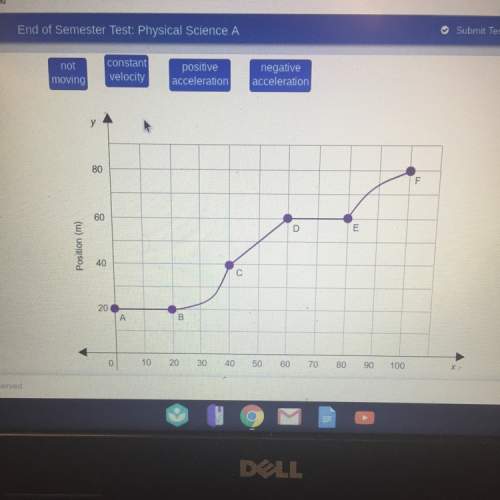
Physics, 13.10.2020 04:01 buglerboy979
A space vehicle is coasting at a constant velocity of 16.9 m/s in the y- direction relative to a space station. The pilot of the vehicle fires a RCS (reaction control system) thruster, which causes it to accelerate at 0.395 m/s^2 in the x direction. After 38.8 s, the pilot shuts off the RCS thruster. After the RCS thruster is turned off.
Find:
a. The magnitude.
b. The direction of the vehicle's velocity relative to the space station. Express the direction as an angle (in degrees) measured from the y- direction

Answers: 1


Another question on Physics

Physics, 21.06.2019 23:00
In a given chemical reaction, the energy of the products is greater than the energy of the reactants. which statement is true for this reaction?
Answers: 2

Physics, 22.06.2019 10:40
As you are trying to move a heavy box of mass m, you realize that it is too heavy for you to lift by yourself. there is no one around to , so you attach an ideal pulley to the box and a massless rope to the ceiling, which you wrap around the pulley. you pull up on the rope to lift the box. use g for the magnitude of the acceleration due to gravity and neglect friction forces. once you have pulled hard enough to start the box moving upward, what is the magnitude f of the upward force you must apply to the rope to start raising the box with constant velocity? express the magnitude of the force in terms of m, the mass of the box.
Answers: 1

Physics, 22.06.2019 21:30
What describes the formation of horizon b? a. forms at the surface b. features parent material c. undergoes the most change d. forms due to decomposed material i think the answer is c. undergoes the most change
Answers: 1

Physics, 23.06.2019 01:00
During the apollo moon missions, astronauts were concerned about the effects of newton's third law of motion when: o a. they ejected waste water, because they were concerned that it would push them off course. o b. they reentered earth's atmosphere, because they were carrying heavy moon rocks. o c. they took off from earth, because a large force was required to generate large acceleration. o d. they detected incoming space debris, because the inertia of the debris could damage their ship.
Answers: 3
You know the right answer?
A space vehicle is coasting at a constant velocity of 16.9 m/s in the y- direction relative to a spa...
Questions

English, 01.07.2019 11:10



Mathematics, 01.07.2019 11:10



Mathematics, 01.07.2019 11:10

Mathematics, 01.07.2019 11:10


Spanish, 01.07.2019 11:10


History, 01.07.2019 11:10



Mathematics, 01.07.2019 11:10

Mathematics, 01.07.2019 11:10




Mathematics, 01.07.2019 11:20




